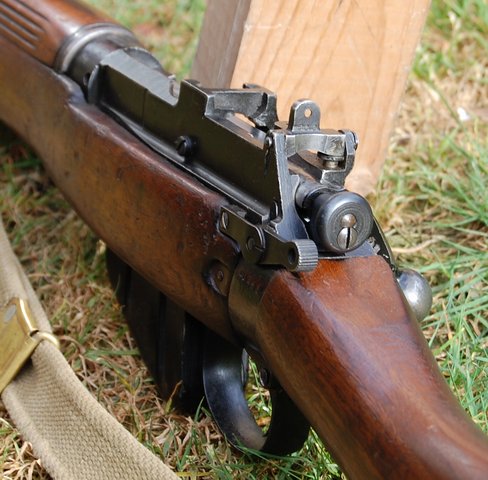-
FREE MEMBER
NO Posting or PM's Allowed

Cocking piece difference in No1 and No4 etc
Before I ask this question I want to say that I did a brief search and did not find my answer.
Why did the cocking piece on the No4 not have a shoulder or rim on it for better grip? To me it seems like a de-evolution in progress over the older rifles. Even with the grooves on the piece, there does not seem to be the control. I do know of some people who have allowed the piece to slip while releasing the mechanism.
I should qualify that my mindset is one more of recreation than military so I could be missing something there. I should also plead ignorance when it comes to knowing if certain factories did this while others did not in the same period. I am merely making an assumption that No1 and 4 were different.
Information
 |
Warning: This is a relatively older thread
This discussion is older than 360 days. Some information contained in it may no longer be current. |
|
-
06-18-2010 01:40 PM
# ADS
Friends and Sponsors

-
There's a one word answer. Cheapness............... If you want to elaborate, there's a further few words. Simplicity of manufacture
-
Thank You to Peter Laidler For This Useful Post:
-
-
FREE MEMBER
NO Posting or PM's Allowed

Was there a high rate of accidental discharge from these rifles when you mix in rain, mud, snow and just plain numbness from cold? I suspect that they could slip rather easily.
-
-
-
Legacy Member

The early ones did

and it was soon dropped for faster production. You shouldn't be using the cocking piece in this way anyway, as related above.
-
Thank You to Mk VII For This Useful Post:
-
Legacy Member


Originally Posted by
Mk VII

The early ones did

and it was soon dropped for faster production. You shouldn't be using the cocking piece in this way anyway, as related above.
Wow, that IS a pretty cocking piece! Nice, No.4. Can we see more pictures?
"Self-realization. I was thinking of the immortal words of Socrates, who said, "... I drank what?"
-
-
Advisory Panel


The main purpose of any gripping surface on the cocking piece is to enhance re-cocking after a misfire, or de-cocking on an empty chamber. Trying to ease the striker down onto the primer of a live round is a really bad idea. Even if successful, having the firing pin resting on a live primer is a very hazardous condition since an inadvertent blow to the cocking piece, or even banging the muzzle or butt on a hard object, can set the round off. If the rifle has a safety, that's what we use to prevent unintended discharge. If it doesn't, we open the action.
FWIW, many No.1 rifles have a grooved cocking piece and, as we see above, some early No.4's had a round, rimmed one.
-
Thank You to Parashooter For This Useful Post:
-
Legacy Member

The Enfield also has a "half-cock" feature, only way to achieve it is to hold on to the cocking piece and pull the trigger, that way the firing pin would not be resting on the primer. Can't see why anyone would want to use it though instead of the regular safety catch.
-
-
Advisory Panel


If you'd like to find out a real purpose for the "half-bent" feature, full-cock the piece, place the safety lever a little less than halfway to the "on" position, pull the trigger, release it, then flip the safety "off". Now imagine what would happen without the half-bent notch, with a round up the spout.
-
Thank You to Parashooter For This Useful Post:
-
Legacy Member

Interestingly, the first Lee Metfords had a safety lever reminiscent of the later SMLE.
It was apparently not a roaring success, as the Mk1* and 11 models did away with it altogether.
The Lee Metford Carbine introduced the "chunky" cocking piece with attached safety lever and this feature then carried on into the Mk 11* Metfords and Lee Enfield series.
The SMLE introduced a new (and greatly improved trigger system and the safety mechanism went back to where it had started in 1888, but with significant improvements.
Note that the nice rounded button look on the cocking piece was not there for looks. It was designed to protect the operator's hand during bayonet fighting: the spirit of the pike died hard. The "blocky" grooved model was originally an "expedient" for wartime. As noted, the early No4s started out with the expensive one in the picture above, but that fell by the wayside fairly quickly. Ditto the elegant machining involved in forming the radiussed surface on the forward tang around the safety stud.
Tech nerd note: On a SMLE, the "safety lever" manipulated by the operator is called the "BOLT, Locking". This is probably because it is externally threaded to drive the other bit and, when rotated, draws the cocking piece rearwards and clear of the sear. The funny-looking ring with a lug and cool 8-start left-hand thread, is called the "CATCH, Safety" and acts to prevent bolt rotation.
From a machinists point of view, the SMLE "Bolt, Locking is a gem. cutting that multi-start thread down the shank, right up to the lever would have been quite interesting to watch. No wonder that the No4 "Bolt, locking" was fabricated from a separate lever and shank, held together with a hard steel pin.
-
The Following 3 Members Say Thank You to Bruce_in_Oz For This Useful Post:















 Register To Reply
Register To Reply













